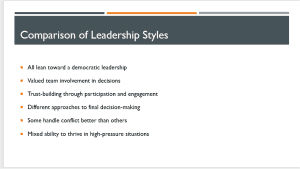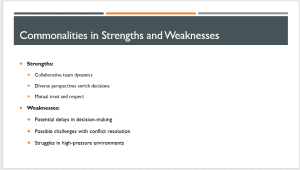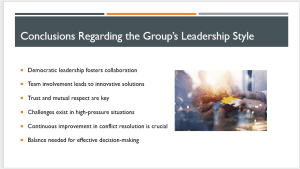Exploring Leadership Styles, Interprofessional Communication, and Servant Leadership in Nursing Practice
Hello and welcome.
Let’s first discuss our leadership style, attributes, and practices. Here, we will talk about how our goal involves the whole team in the decision-making process, increasing trust and mutual respect while strengthening collaboration. Moreover, we’ll be looking at the leadership styles in our group and how they compare, as well as pointing out their common strengths and weaknesses.
To begin, my leadership style is democratic since I am always looking for ways to invite my team members to take part in the decision-making process by collaborating and being engaged. Despite the fact that during the process, I set the boundaries and have the last authority over decisions, I appreciate the thoughts and perceptions of my team. This model creates trust among the team members by ensuring that everyone in the team can feel part of the process. Nevertheless, it may be a drawback in a stressful environment where fast decisions are required, hence longer thinking process might decrease efficiency. Moreover, there could be a problem with my resistance to disputes and conflicts because I prefer working in an environment where there is no conflict. Together, we have a democratic leadership style that enables cooperation and shared responsibility.
A democratic or participative leadership style is adopted by every team member, which includes the idea of decision-making in a democratic way and prioritizing team participation and engagement. Collaboration, which also lays down the ground rules for a trustworthy environment, is a common approach that helps develop a cohesive work environment (Voet & Steijn, 2020). Nevertheless, it can be observed that every member has a different style when arriving at the last decision. Some of them may be more prone to tend to their judgment, and some put more importance on what others think. Though the majority of the group might be able to manage conflicts reasonably well, some members might have a problem disagreeing. Similarly, the ability to thrive in high-pressure situations varies across the group.
Team members in the group have similar qualities, such as a collaborative teamwork approach and mutual trust and respect, which provide space for a healthy working relationship among each other. Members of the group bring diverse perspectives to decision-making. This makes the process more exciting and gives room for original solutions. Nevertheless, the risks of compromising the speed and efficiency of decision-making may increase because of the necessary consultation (Ragazou et al., 2023). Furthermore, some members of the team may find conflict resolution daunting, and as a result, it may have a negative influence on productivity. Such a high-pressure predicament may be a challenge for the team as a whole, and it may take much time for the team to reach decisions and take appropriate actions (Kahraman & Haktanır, 2024). However, the same attributes become the source of the group’s strengths and weaknesses, which creates a balanced and successful team.
Overall, our democratic leadership style promotes collaboration and shared responsibility, leading to innovative solutions and a strong team dynamic. Making our team part of the decision-making process will help us develop strong relationships and mutual respect, which are the pillars of a successful workplace. Nevertheless, difficulties might appear under high pressure and quick decision-making. To be as effective as we can in our roles as leaders, we should aim to improve our conflict management skills and, at the same time, balance the trade-off between speedy decision making and team inputs. Eventually, these practices will stick and communicate that we are a cohesive and prepared team.
ORDER A PLAGIARISM-FREE PAPER HERE
We’ll write everything from scratch
Question
The purpose of this assignment is to assess leadership styles, traits, and practices as a nursing professional, establish the importance of effective interprofessional communication as a leader in nursing, and to explore the role of servant leadership in nursing practice.
Exploring Leadership Styles, Interprofessional Communication, and Servant Leadership in Nursing Practice
Read the study materials on leadership and complete the topic quiz activities to better understand your leadership qualities.
Upon completion, summarize and share with your group what you learned about your specific leadership qualities, so you can become familiar with how you are similar and different from your peers when it comes to being a leader.
Compare the personal leadership styles, traits, and qualities of your group members, including commonalities between group members’ strengths and weaknesses.
Each group member: Create a slide that summarizes your leadership style, traits, and practices.
You lean toward a democratic or participative style of leadership. You tend to set the parameters for the work and have the final say on decisions, but you actively involve your team members in the process. This style can build trust between you and your people, as they’ll likely feel engaged and valued. But it’s not great in a high-pressure situation that requires a fast turnaround, as it will slow you down. And, if you dislike disagreement or conflict, you might struggle with how people respond to consultation. THE GROUP LEADS TOWARD DEMOCRATIC OR PARTICIPATIVE STYLE LEADERSHIP.







